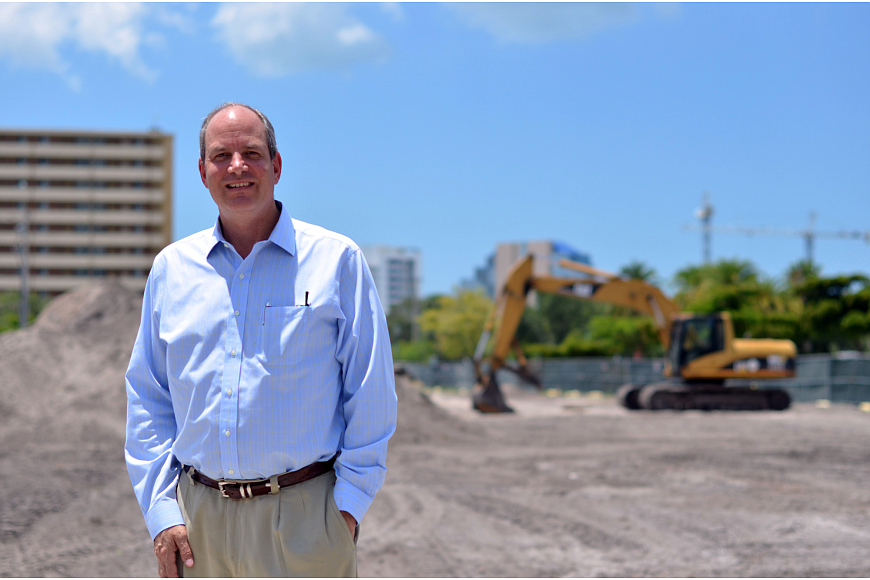- April 16, 2024
-
-
Loading

Loading

Three key developers of Rosemary District rental housing projects are opposed to joining the self-taxing Downtown Improvement District — for now, at least.
At a Nov. 12 meeting, the developers said their reluctance stems from uncertainty. Their projects will be the first large apartment developments in the area, and they aren’t sure what to expect. As a result, the group exploring the possible expansion of the DID began to accept that the Rosemary District isn’t ready to join just yet.
“The last thing we want to do is give these guys any heartburn of any shape, size and form,” said Ian Black, chairman of the DID expansion study committee formed by the city of Sarasota.
In expressing their fear regarding new expenses — the DID currently charges commercial property owners within its boundaries a 2-mill property tax — the developers highlighted uncertainty associated with the growth of the Rosemary District, even as construction begins on hundreds of new residential units.
“Bringing 1,000 units means bringing 1,500, 1,700 people into a neighborhood that hasn’t seen that kind of activity — ever,” said Phillip Smith, president of the Tampa-based developer of a Rosemary housing project. “That’s a whole other world from what it is today.”
That project, Sarasota Flats, will add 228 units to the Rosemary District. Elan Rosemary will bring another 295, and CitySide will add a total of 489 units after both phases of the project are finished. Thanks to the density bonus created by the Rosemary Residential Overlay District in 2014, developers can include up to 75 units per acre in individual projects — leading to the surge in rental housing.
"It’s not the time to be adding additional cost on, which will really impede future development." — Lewis Stoneburner
Despite the investment in the neighborhood, groups spearheading these projects don’t know if the market can sustain the amount of housing that’s already coming. They believe there’s room for continued growth, but they’re not even sure what prospective tenants would be comfortable paying for rent.
“We’re still pioneers,” said Debra Alward, chief operating officer for the developer of CitySide. “We don’t know exactly what this will be like, so we still look at this as kind of a high-risk proposition.”
For the purposes of a business improvement district, these rental projects would be considered commercial properties subject to taxation. If a new tax were imposed on the Rosemary District — even one lower than the current 2-mill DID tax — it could shift profit models and discourage investment in the area, according to Elan Rosemary developer Lewis Stoneburner.
“It’s a district that’s just starting to transform into a cool, hip, eclectic artsy-type district,” Stoneburner said. “In my personal opinion, it’s not the time to be adding additional cost on, which will really impede future development.”
The developers agreed new costs would likely be passed onto prospective residents. At this point, they said, introducing an additional variable into the market isn’t desirable.
“We want all the residents to be treated equally, the people who own and rent homes,” Alward said. “It seems to us, when we’re trying to attract these new people to come in, that they shouldn’t be penalized for being pioneers, too, in a way.”
"It's not a residents improvement district. It's a business improvement district." — Ken Shelin
Ken Shelin, a former city commissioner and a member of the expansion committee, said his research indicated residents don’t derive the same benefit as commercial property owners from investment in an improvement district.
“It’s not a residents improvement district,” Shelin said. “It’s a business improvement district.”
The DID originally targeted the Rosemary District because, as the neighborhood redevelops, officials believed it could benefit from the type of improvement projects downtown has seen in the past five years. The city is already working on redesigning a more pedestrian-friendly Fruitville Road, linking the neighborhood to the downtown core.
Although current Rosemary tenants might offer suggestions for immediate improvement — the expansion committee mentioned homelessness as a top issue — Stoneburner said the neighborhood’s dynamics could shift radically once the residential projects are complete.
“The needs today may be vastly different than the needs when you have 700 new apartments and two or three condo projects and a new hotel,” Stoneburner said.
Once their projects have full occupancy, the developers said, they’d be willing to discuss the logistics of creating an improvement district once again.
Although they highlighted a series of questions regarding their investments, the developers also shared their enthusiasm for the potential of the Rosemary District given the current economic climate. As a result, they were disinclined to tinker with the existing dynamics.
“I’d hate to stifle the growth,” Stoneburner said. “You’ve got some very exciting projects going on.”